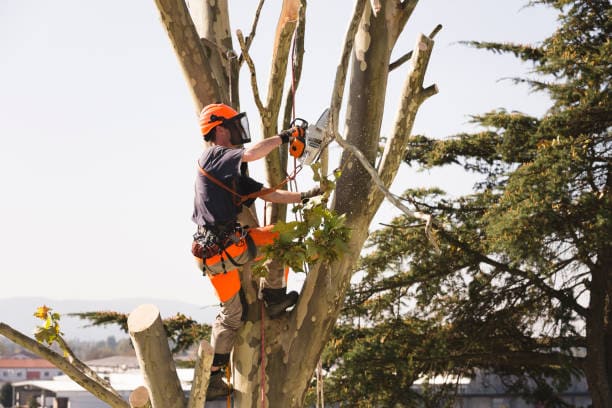Written by Laura Foreman and published on https://davesgarden.com/
As leaves fall from the trees each autumn, branches formerly covered in a canopy of dense foliage come out of hiding. Although many gardeners would rather never deal with the falling mess of leaves, I relish this time as an opportunity to inspect each tree canopy. It’s now that I carefully make note of any branches I may need to remove from my trees. Taking advantage of these dormant months gives me time to develop a plan for pruning and trimming trees in my landscaping.
Table of Contents
To Prune or Not to Prune
Thinking of pruning your fruit trees? Late fall is a perfect time.
The autumn has arrived. Just because you’re collecting the last of your harvest doesn’t mean you’re done in the garden yet. The late fall is the ideal time to prune your fruit trees before they go dormant. Sure, you can prune them anytime between late fall and early spring, but pruning now will ensure you’re not outside in the freezing cold, wielding your pruning shears and dangling precariously from a ladder.
Benefits of Pruning
Pruning is vital if you want healthy and productive fruit trees that generate large harvests. Additionally, pruning stimulates vigorous growth the following spring, which should be shaped in the following fall to ensure the crown and root system are balanced.
Pruning Techniques Start-To-Finish
As vital and simple a practice as pruning can be, there are ways you can go about it that will guarantee you the best results and help you avoid common problems that can harm your garden. One of the first things to do is to identify when it’s time to prune. For instance, only prune your trees during periods when they are dormant. Pruning a non-dormant tree can send signals to the plant that it’s time to grow again. While this is a trait that gardeners can exploit to encourage new growth in the proper season, when a plants send out new growth right before the temperatures drop it can cause the plant to die. Additionally, by the time the tree is dormant, its leaves have fallen from the branches giving you a clear view of the shape of the tree and its branches, which makes it much easier to figure out where to cut.
Sharpen and clean your tools. Sharp blades are less traumatizing for the tree, as you don’t have to hack away to remove the branches. Similarly, clean and sanitized tools ensure the disease isn’t spread from tree to tree.
Mind the angle. Choose wide angles as you cut and prune outward, in the direction you intend the limbs to grow. The goal is to create a full crown – a full crown encourages air flow and creates space for ample harvest.
The physical location of your cut will depend on the type of fruit tree you’re pruning. Trees like apples, pear, and cherries are best pruned along a central leader, which is the trunk. The idea is to encourage growth primarily from the central trunk by removing branches that grow from other limbs and maintain a healthy shape. Remove about 20 percent of the previous year’s growth.
For peaches and plums, it’s best to aim for a vase-shape comprised of 3 or more limbs from the trunk. The intent is to remove any limbs and branches that cross one another and impede growth. You’ll want to remove about half of the year’s growth.
Vine fruit like grapes and kiwi should also be pruned after the harvest. You’ll also want to remove half of the previous year’s growth. If you have citrus trees, you’ll want to ensure the branches don’t touch the ground so you may even want to overprune limbs a bit, so that there’s no threat of them reaching the ground.
Inspect the tree as you cut. Pruning allows you to inspect the tree and look for any signs of disease or pest infestation. Remove diseased or broken limbs and branches as well as suckers and any competing branches. This will help save the tree, prevent the disease from spreading and encourage healthier growth. If you have competing branches and you’re not sure which to cut, keep the one that had the strongest, healthiest growth the previous year.
Concentrate on the top. Sunlight is essential to healthy growth and large harvests. Prune heavily at the top to not only to control growth but also ensure that the bottom branches also receive the sunshine they need to grow.
Pruning in the Off Season
You may still prune after harvest when the tree isn’t dormant if your tree is overgrown or growing too quickly. Avoid it if you can, but if it’s a must then prune as you normally would and then thin the tree after you’ve harvested the fruit.
Don’t be afraid to prune a young tree. Gardeners are often nervous about pruning young trees, thinking they’ll impede future growth. However, heavy pruning when the tree is young – that is, less than 3 years – will help it grow faster and allow you to create the right shape as it grows.
3 Reasons to Hire Pruning Help
The trees are large or haven’t been pruned in a while. Whether you’ve forgotten to prune the tree for several years or you’ve purchased property with overgrown fruit trees, you may wish to pay someone to prune the tree this year. It can be a daunting process when you’re unfamiliar with a plant’s history and if you’re not sure what to cut. Having an expert handle it will ensure you don’t damage the tree and stifle next year’s harvest.
Another set of skilled hands can also be useful if you’re unsure of your own knowledge or ability. Pruning takes skill and ability, so while this may be a good resource for information, if you’re not comfortable climbing up a ladder to cut limbs and branches, it may be best to leave it to the professionals or have a green-fingered friend tackle the task for you.
Maybe you just don’t have the time! It’s a busy time of year for many people, between harvesting, preparing for the holiday season, and getting the home’s exterior ready to handle the cold temperatures and inclement weather. Depending on the number of trees you have, pruning can be a time consuming process. If you’re not sure you have the time, hire someone else to handle it.
Original post here https://davesgarden.com/guides/articles/to-prune-or-not-to-prune/.

